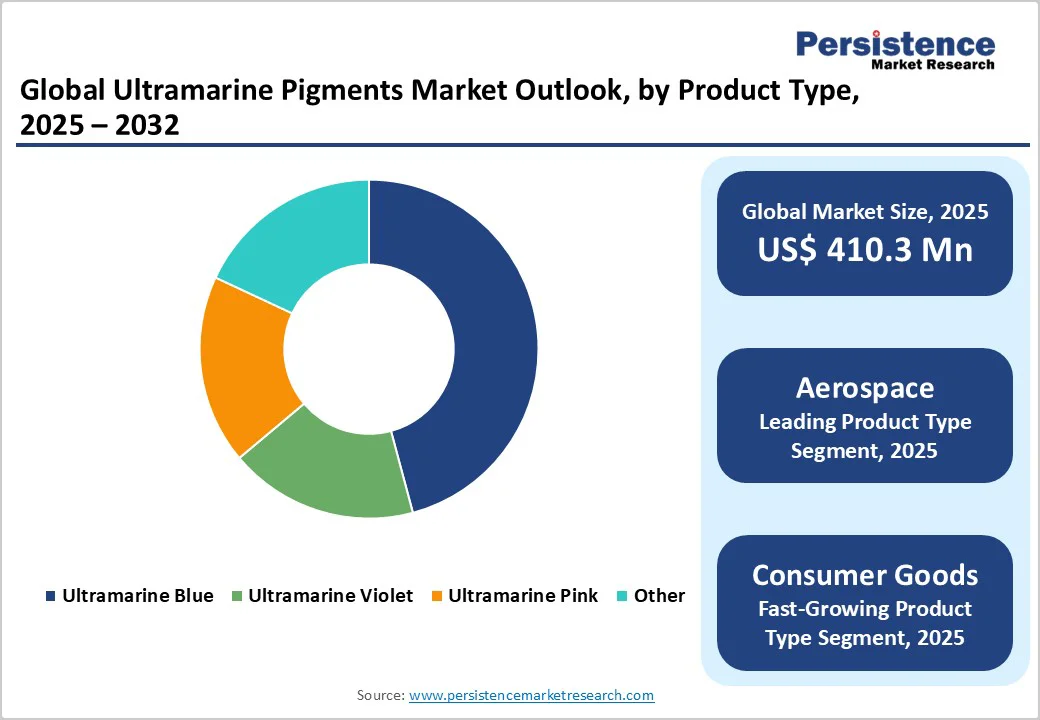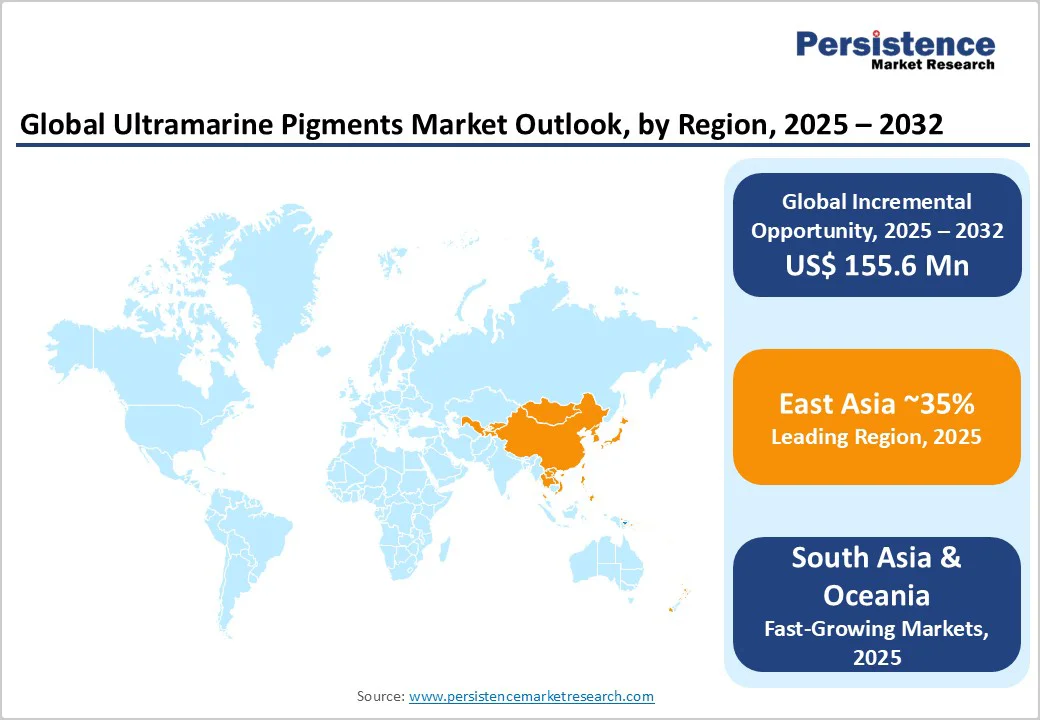ID: PMRREP15019| 201 Pages | 5 Nov 2025 | Format: PDF, Excel, PPT* | Chemicals and Materials

The global ultramarine pigments market size was valued at US$410.3 Million in 2025 and is projected to reach US$565.9 Million by 2032, growing at a CAGR of 4.7% between 2025 and 2032, driven by increasing demand across construction, automotive, and cosmetics industries, supported by growing environmental consciousness and regulatory preference for non-toxic, sustainable pigments. Key growth catalysts include infrastructure development in the emerging markets, technological advancements in pigment manufacturing processes, and rising consumer demand for vibrant, durable colorants in specialty applications.
| Key Insights | Details |
|---|---|
|
Ultramarine Pigments Market Size (2025E) |
US$410.3 Mn |
|
Market Value Forecast (2032F) |
US$565.9 Mn |
|
Projected Growth (CAGR 2025 to 2032) |
4.7% |
|
Historical Market Growth (CAGR 2019 to 2024) |
3.9% |

Industrial growth and global infrastructure advancements serve as key market drivers for ultramarine pigments. According to government data, global construction expenditure is significant, with India increasing capital expenditure by 11.1% to US$133 Billion in FY 2024-25, accounting for 3.4% of its GDP.
The U.S. construction sector's annual spending amounts to US$2.2 Trillion in 2024, representing 4.5% of GDP. Such significant investments necessitate durable, aesthetically pleasing, and cost-effective pigment solutions such as ultramarine pigments for coatings and concrete applications. These large-scale developments in construction and infrastructure projects demand high-quality pigments, directly bolstering the market. The market response to these dynamics reflects steady consumption in pigment applications, especially in coatings, architectural paints, and industrial materials.
Technological progress in synthesizing ultramarine pigments enhances their performance, safety, and environmental compliance. Recent innovations focus on improving pigment stability, color consistency, and eco-friendliness, aligning with global regulatory trends toward sustainable manufacturing.
Advances also include formulations tailored for personal care and cosmetics, promoting safer ingredients as reflected in regulatory guidelines from agencies such as the U.S. FDA and the European Chemicals Agency (ECHA). These developments facilitate the entry of ultramarine pigments in sensitive applications such as cosmetic-grade products, stimulating demand, and enabling market diversification. The resulting benefits include expanded end-user applications and increased product acceptance across multiple industries.
Heightened global regulatory scrutiny favors the adoption of environmentally benign pigments. Authorities, including the European Union, have implemented stringent guidelines under REACH regulations, emphasizing low toxicity and sustainability in chemical use. The U.S. Environmental Protection Agency (EPA) promotes low-impact industrial chemicals, driving pigment manufacturers to innovate within strict compliance frameworks.
This regulatory landscape accelerates the transition towards ultramarine pigments, which are renowned for non-toxic and inert properties, compared to alternatives with heavy metals or hazardous compounds. Consequently, regulatory-driven substitution effects expand the market as industries seek compliant and sustainable pigment solutions.
The market faces significant cost barriers related to raw material sourcing and manufacturing complexity. The synthetic processes involve specialized materials such as kaolin and sulfur, with fluctuations in availability impacting production costs. Supply chain disruptions owing to geopolitical tensions and logistical limitations continue to pose risks.
For instance, volatile sulfuric acid prices in Asia Pacific have increased production expenses by approximately 8% during 2023-2024. These factors restrict price competitiveness, particularly against lower-cost pigment alternatives, hindering wider adoption across cost-sensitive markets.
Market players contend with competition from alternative pigments such as titanium dioxide and organic dyes, exhibiting specific functional advantages. Titanium dioxide, often favored for whiteness and brightness, presents a significant challenge, particularly in coating and packaging applications.
Though ultramarine pigments offer unique color hues and cost benefits, the dominance of well-established pigment types limits their penetration in certain segments. Furthermore, aggressive pricing strategies by major titanium dioxide producers reduce ultramarine pigment attractiveness in low-margin sectors. This competitive pressure compels manufacturers to innovate and differentiate their product offerings continuously.
Developing economies, particularly in the Asia Pacific region, present substantial growth. An emerging opportunity lies in the increasing preference for natural and safe pigments in personal care and cosmetics. Regulatory agencies worldwide mandate stringent safety evaluations for cosmetic ingredients, driving manufacturers toward synthetic mineral pigments such as ultramarine. This shift aligns with consumer demand for non-toxic and hypoallergenic products, enabling ultramarine pigments to capture market share in cosmetic applications.
With rising disposable incomes and growing awareness of ingredient transparency, cosmetic manufacturers are integrating ultramarine violet and other novel pigment variants to meet these expectations. This trend creates actionable potential for pigment producers to develop specialized grades catering to this lucrative sector.
The global automotive sector presents a considerable opportunity for ultramarine pigments, especially within high-performance coatings. Data from 2024 highlighted a global car production volume of over 75 million units, underscoring the substantial market for pigments used in vehicle coatings. Automotive manufacturers increasingly demand pigments with superior durability, color fastness, and environmental compliance to meet regulatory standards and consumer preferences.
Ultramarine pigments, particularly ultramarine violet with enhanced UV resistance, are well-positioned to fulfil these technical requirements. Investment in automotive coatings aligned with electrification and sustainable manufacturing initiatives reinforces this segment’s potential for growth.
The industrial grade segment dominates the market with a commanding 78% share in 2025, driven by extensive usage in construction, automotive, and coating industries. Its popularity stems from cost-effectiveness and versatility in industrial applications where high durability and color consistency are critical. Government infrastructure data, particularly from countries, including India and the U.S., supports sustained demand through expansive building projects requiring industrial-grade pigments for coatings and finishes. The cosmetic grade segment emerges as the fastest growing, reflecting accelerated adoption in personal care products. This growth is linked to rising consumer preference for non-toxic, safe pigments with regulatory backing from bodies such as the U.S. FDA and ECHA.
Cosmetic-grade ultramarine pigments meet stringent purity and safety requirements, facilitating their increased use in formulations such as makeup, skincare, and toiletries. The shift towards clean beauty and regulatory emphasis on ingredient safety amplifies this segment’s relevance and growth potential.
Ultramarine blue holds the leading position with approximately 80% market share in 2025. Its widespread applicability across several sectors, such as paints, plastics, and construction materials, underscores its prevalence. Ultramarine blue’s robust chemical stability, vibrant color profile, and cost advantages underpin its dominant market stance. It serves as a critical pigment in architectural paints, adhering to stringent environmental and durability standards globally.
Ultramarine violet is the fastest-growing segment, leveraged for specialized applications demanding enhanced aesthetics and UV resistance. The pigment's integration into automotive coatings and cosmetic products is notable, fueled by ongoing technological improvements that enhance pigment performance. Governmental policies promoting sustainable automotive paints and cosmetic safety standards further support ultramarine violet’s escalating demand.
The construction sector constitutes the leading end-use segment with a 30% market share in 2025. This is attributed to the massive global construction activity, reflected in regional government expenditures such as India’s FY 2024-25 capital expenditure of US$133 Billion and the U.S. construction sector’s US$2.2 Trillion annual spending.
Ultramarine pigments are widely utilized for cement, concrete, and architectural paints, meeting stringent longevity and color retention demands. The automotive segment stands as the fastest-growing end use, representing 25% of the market in 2025. Growth is linked to increasing vehicle production volumes exceeding 75 million units globally and rising adoption of color-stable, eco-friendly pigments in automotive coatings. Government policy incentives supporting electric vehicle penetration and sustainable manufacturing underscore this sector’s expanding pigmentation needs. Ultramarine pigments’ chemical robustness and environmental compliance make them ideal for evolving automotive industry requirements.

East Asia dominates the market with a 35% share, led by China, Japan, and South Korea. China’s construction and automotive sectors are major consumers, with government-backed infrastructure spending exceeding US$1 Trillion in 2024.
Japan and South Korea emphasize high-quality coatings in automotive and consumer goods, supported by stringent environmental and safety regulations. Rapid urbanization, industrial production growth, and policy incentives for sustainable pigments reinforce regional demand, while domestic manufacturers leverage low-cost production and export opportunities to global markets.
North America accounts for 28% of the ultramarine pigments market, supported by a mature industrial base and high per-capita consumption. The U.S. construction sector alone contributes US$2.2 Trillion annually to the economy, fostering a strong demand in architectural coatings utilizing ultramarine pigments.
North America boasts a leading automotive industry with active incorporation of advanced pigment technologies for sustainable vehicle production. Government stimulus efforts on infrastructure modernization and environmental regulations, such as TSCA, influence pigment market dynamics. The competitive landscape is characterized by established manufacturers investing in product innovation and broad geographic reach within the U.S. and Canada.
Europe contributes 22% to the ultramarine pigments market, with demand primarily driven by construction and automotive sectors, emphasizing eco-friendly pigment adoption. EU REACH regulations impose stringent safety and environmental standards that shape production and application trends. Although the overall construction output slightly declined in late 2024, countries such as Poland, Spain, and Czechia experienced growth, highlighting variations in regional demand.
The German automotive industry, a European leader, integrates ultramarine pigments extensively in premium and electric vehicle coatings. Germany alone produced 4.1 million passenger cars in 2024 and maintains 106,000 EV charging stations nationwide. European manufacturers leverage high R&D investments to innovate pigment formulations aligned with sustainability targets and consumer safety requirements.

The global ultramarine pigments market is characterized by a fragmented competitive landscape, featuring a mix of multinational corporations and regional players. Key industry leaders include Ferro Corporation, DIC Corporation (Sun Chemical), Venator Materials PLC, BASF SE, and Ultramarine & Pigments Ltd. These companies dominate the market through extensive production capabilities, global distribution networks, and substantial investments in research and development.
Regional players such as Lapis Lazuli Pigments Co., Ltd., Habich GmbH, R.S. Pigments, Dominion Colour Corporation, and Yipin Pigments Inc. contribute to the market's diversity by offering specialized products tailored to local demands. The market's fragmented nature allows for innovation and customization, catering to various applications across industries such as paints and coatings, plastics, cosmetics, and detergents. This structure fosters healthy competition and continuous advancement in pigment technology.
The ultramarine pigments market is projected to be valued at US$410.3 Million in 2025.
The ultramarine blue segment is expected to hold around 80% market share in 2025, driven by its widespread uses across various applications such as paints, plastics, and construction materials, owing to its strong chemical stability, vibrant color profile, and cost-effectiveness.
The ultramarine pigments market is poised to witness a CAGR of 4.7% from 2025 to 2032.
The ultramarine pigments market growth is driven by extensive industrial expansion and infrastructure investments requiring durable pigments, technological advancements enhancing pigment safety and environmental compliance, and stringent global regulations promoting eco-friendly and non-toxic pigment adoption.
Key market opportunities for ultramarine pigments lie in the growing cosmetic industry in Asia-Pacific, driven by demand for safe and non-toxic pigments, and in automotive coatings, supported by over 75 million global vehicle productions in 2024, requiring durable, color-stable, and eco-friendly pigments.
The key market players in the ultramarine pigments market include Ferro Corporation, DIC Corporation (Sun Chemical), Venator Materials PLC, BASF SE, and Ultramarine & Pigments Ltd.
| Report Attribute | Details |
|---|---|
|
Forecast Period |
2025 - 2032 |
|
Historical Data/Actuals |
2019 - 2024 |
|
Market Analysis |
US$ Mn |
|
Geographical Coverage |
|
|
Segmental Coverage |
|
|
Key Companies Covered |
|
|
Report Coverage |
|
By Grade
By Product Type
By End-user Industry
By Region
Delivery Timelines
For more information on this report and its delivery timelines please get in touch with our sales team.
About Author